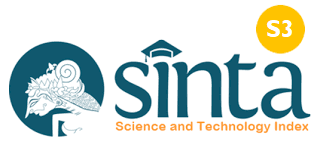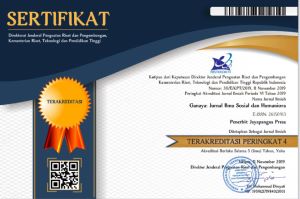The Role of Women in Community Development after Earthquake, Tsunami, and Liquefaction in Central Sulawesi, Indonesia
DOI:
https://doi.org/10.37329/ganaya.v4i2.1420Keywords:
Palu disaster, liquefaction, tough women, socioeconomic collapse, sustainable recoveryAbstract
This study aims at identifying how women respond to uncertain situations after a disaster. Women and children are frequently in a vulnerable position due to their domestic roles. The research took place in Central Sulawesi, where the massive earthquake, tsunami, and liquefaction engulfed thousands of lives and dwellings. Despite their limitation, women have become a social catalyst in enhancing optimism among the survivors. The socio-cultural background of Central Sulawesi women is an essential factor in recovering socio-economic conditions after the disaster in Central Sulawesi. Their toughness and high social care have also facilitated extensive social and economic activities, along with women activists in civil society organizations. Several non-governmental organizations under government coordination have provided rehabilitation assistance programs. The research employed qualitative approaches encompassing in-depth interviews, focus group discussions, and field observations. The research indicates that women's greater participation in disaster recovery programs could be essential. Women also brought up people's optimism to bounce back faster from suffering a disaster.
References
Ahdiah, I. (2017). Nosalia Poboti Pentas Peran Perempuan Suku Kaili di Kota Palu. Jurnal Online Kinesik, 4(1), 1–8.
BPS Kota Palu, Kota Palu dalam Angka 2019, Badan Pusat Statistik Kota Palu, 2019.
BPS Sulawesi Tengah, Provinsi Sulawesi Tengah dalam Angka 2018, Badan Pusat Statistik Sulawesi Tengah, 2018.
Daryono, M. R., Natawidjaja, D. H., Pamumpuni, A., & Gunawan, E. (2018). Survei Offset Permukaan Gempa Palu 2018. In Kajian Gempa Palu Provinsi Sulawesi Tengah. Pusat Studi Gempa Nasional Balitbang Kementerian PU - PR.
Dhameja, A. (2008). Disaster Rehabilitation: Towards a New Perspective. In Disaster Management Handbook. CRC Press.
Felten-Biermann, C. (2006). Gender and Natural Disaster: Sexualized violence and the tsunami. Development, 49(3), 82–86. https://doi.org/10.1057/palgrave.development.1100276
Fikri, Ahmad, Kenapa Petobo Terdampak Paling Parah Likuifaksi? Simak Kata Ahli, https://tekno.tempo.co/read/1132735/kenapa-petobo-terdampak-paling-parah-likuifaksi-simak-kata-ahli, diakses 26 Agustus 2019 pukul 17.09 WIB.
Gokhale, S. D. (2001). Social/Economic Rehabilitation. International Journal of Leprosy, 69(2). http://ila.ilsl.br/pdfs/v69n2s1a08.pdf
Gokhale, V. (2008, October 12). Role of women in disaster management: An analytical study with reference to Indian society. The 14 th World Conference on Earthquake Engineering, Beijing. https://www.iitk.ac.in/nicee/wcee/article/14_10-0049.PDF
Hallegatte, S., Jun Erik, M. R., & Brian James, W. (2018). Building back better: Achieving resilience through stronger, faster, and more inclusive post-disaster reconstruction. World Bank Group. http://documents.worldbank.org/curated/en/420321528985115831/Building-back-better-achieving-resilience-through-stronger-faster-and-more-inclusive-post-disaster-reconstruction
Hunt, A., & Samman, E. (2016). Women’s economic empowerment Navigating enablers and constraints [Research Report]. Overseas Development Institute. https://www.odi.org/sites/odi.org.uk/files/resource-documents/10683.pdf
Maarif, S. (2012). PIKIRAN dan GAGASAN Penanggulangan Bencana di Indonesia (First Edition). Badan Nasional Penanggulangan Bencana (BNPB) RI.
Matarrita-Cascante, D., & Brennan, M. A. (2012). Conceptualizing community development in the twenty-first century. Community Development, 43(3), 14.
McPherson, K., Gibson, B. E., & Leplege, A. (2015). Rethinking Rehabilitation: Theory and Practice (First). CRC Press.
Miles, M. B., Huberman, A. M., & Saldana, J. (2014). Qualitative Data Analysis: A Methods Sourcebook (Third Edition). SAGE Publications.
Moreno, J., & Shaw, D. (2018). Women’s empowerment following disaster: A longitudinal study of social change. Nat Hazards, 92. https://doi.org/10.1007/s11069-018-3204-4
Nugroho, S. P. (2018). Penangangan Bencana Gempa Bumi M 7,4 dan Tsunami di Sulawesi Tengah. Badan Nasional Penanggulangan Bencana (BNPB) RI. http://fmb9.id/document/1538730425_2018_05_10_Penanganan_gempa_tsunami_Sulawesi.pdf
Ojanen, M. (1996). Persuasion Strategies Applied in Psychosocial Rehabilitation. Journal of Community & Applied Social Psychology, 06, 77–99.
Pemprov Sulawesi Tengah, Rencana Induk Pemulihan dan Pembangunan Kembali Wilayah Pasca-Bencana Provinsi Sulawesi Tengah, Pemerintah Provinsi Sulawesi Tengah, 2018.
Reconstructing after disasters: Build back better. (2015). In UN World Conference on Disaster Risk Reduction (Vol. 151). https://doi.org/10.1145/3132847.3132886
Robinson, J. W., & Green, G. P. (2010). Introduction to Community Development Theory, Practice, and Service-Learning. SAGE Publications.
Robles, F. (2018, July 12). FEMA Was Sorely Unprepared for Puerto Rico Hurricane, Report Says. The New York Times. https://www.nytimes.com/2018/07/12/us/fema-puerto-rico-maria.html
Schlecht, J., Rowley, E., & Babirye, J. (2013). Early relationships and marriage in conflict and post-conflict settings: Vulnerability of youth in Uganda. Reproductive Health Matters, 21(41), 234–242. https://doi.org/10.1016/S0968-8080(13)41710-X
Shevellar, L., Westoby, P., & Connor, M. (2015). Flirting with danger: Practice dilemmas for community development in disaster recovery. Community Development, 46(1), 18.
Sloand, E., Killion, C., Gary, F. A., Dennis, B., Glass, N., Hassan, M., Campbell, D. W., & Callwood, G. B. (2015). Barriers and Facilitators to Engaging Communities in Gender-Based Violence Prevention following a Natural Disaster. Journal of Health Care for the Poor and Underserved, 26(4), 1377–1390. https://doi.org/10.1353/hpu.2015.0133
Tumanggor, R. (2007). PEMBERDAYAAN KEARIFAN LOKAL MEMACU KESETARAAN KOMUNITAS ADAT TERPENCIL. 12(01), 17.
UNISDR. (2017). Build Back Better in recovery, rehabilitation and reconstruction. In UNISDR (Vol. 10, Issue 2).
Wicaksono, Bhakti S., Gempa Usai Hujan Mulai, Ancaman Palu Kini Banjir Bandang dan Longsor, https://sains.kompas.com/read/2018/10/15/203103523/gempa-usai-hujan-mulai-ancaman-palu-kini-banjir-bandang-dan-longsor, diakses 26 Agustus 2019 pukul 17.09 WIB.
Downloads
Published
How to Cite
Issue
Section
License
An author who publishes in the Ganaya : Jurnal Ilmu Sosial dan Humaniora agrees to the following terms:
- Author retains the copyright and grants the journal the right of first publication of the work simultaneously licensed under the Creative Commons Attribution-ShareAlike 4.0 License that allows others to share the work with an acknowledgement of the work's authorship and initial publication in this journal
- Author is able to enter into separate, additional contractual arrangements for the non-exclusive distribution of the journal's published version of the work (e.g., post it to an institutional repository or publish it in a book) with the acknowledgement of its initial publication in this journal.
- Author is permitted and encouraged to post his/her work online (e.g., in institutional repositories or on their website) prior to and during the submission process, as it can lead to productive exchanges, as well as earlier and greater citation of the published work (See The Effect of Open Access).
Read more about the Creative Commons Attribution-ShareAlike 4.0 Licence here: https://creativecommons.org/licenses/by-sa/4.0/.








